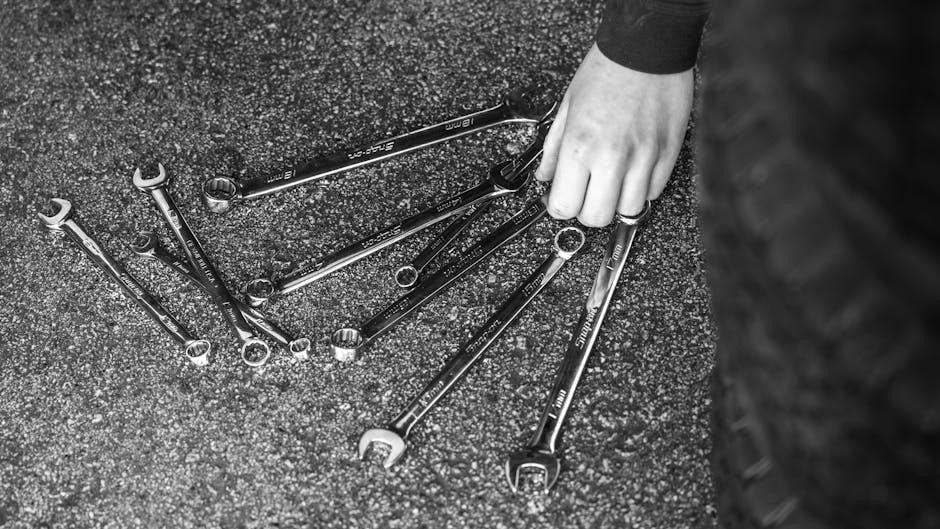The Behringer ADA8000 is a professional 8-channel A/D and D/A converter‚ ideal for studio and live recording. It offers high-quality preamps‚ excellent A/D conversion‚ and flexible connectivity options‚ making it a versatile choice for audio engineers seeking superior sound quality and reliable performance.
1.1 What is the Behringer ADA8000?
The Behringer ADA8000 is a professional 8-channel A/D and D/A converter designed for high-quality audio conversion in studio and live recording environments. It combines analog and digital signal processing‚ offering pristine audio quality with flexible connectivity options. The unit features 8 high-quality microphone preamps‚ ADAT optical I/O‚ and S/PDIF coaxial connectivity‚ making it versatile for various audio setups. Its compact design and robust construction ensure reliability and durability. The ADA8000 is ideal for engineers and producers seeking accurate audio conversion with minimal noise and distortion‚ ensuring professional-grade sound reproduction in both analog and digital domains.
1.2 Key Features of the ADA8000
The Behringer ADA8000 stands out with its 8 premium microphone preamps‚ offering ultra-low noise and high headroom. It features 24-bit/96kHz A/D conversion‚ ensuring high-fidelity digital output. The unit supports ADAT optical I/O for expandability and S/PDIF coaxial for digital connectivity. Its built-in insert jacks allow for external processing‚ while the phase inversion and phantom power on each channel provide flexibility. The ADA8000 also includes LED metering for precise level monitoring and a durable‚ rack-mountable design. These features make it a versatile and reliable choice for professional audio applications‚ catering to both studio and live sound needs with exceptional performance and durability.
1.3 Why Use the ADA8000?
The Behringer ADA8000 is an excellent choice for professionals seeking high-quality audio conversion and flexibility. Its 8-channel design allows for simultaneous processing of multiple signals‚ making it ideal for recording‚ live sound‚ and studio applications. The unit’s low-noise preamps and precise A/D conversion ensure clean‚ accurate sound reproduction. Its compatibility with various digital formats and expandability via ADAT optical I/O make it a versatile tool for modern audio workflows. Additionally‚ the ADA8000 is built to last‚ with durable construction and intuitive controls‚ making it a reliable investment for audio engineers and musicians alike. Its functionality and sound quality make it a standout in its class.

System Requirements and Compatibility
The Behringer ADA8000 is compatible with both Windows and macOS operating systems‚ requiring minimal hardware specifications for smooth operation. It integrates seamlessly with popular DAWs‚ ensuring reliable performance across various setups.
2.1 Operating System Compatibility
The Behringer ADA8000 is compatible with both Windows and macOS operating systems‚ ensuring versatility for different workflows. It supports Windows 10 and above‚ as well as macOS 10.13 or later versions. This broad compatibility allows seamless integration into various recording environments. The device is driver-dependent‚ and Behringer provides drivers for both operating systems‚ ensuring optimal performance. Regular updates are recommended to maintain compatibility with the latest OS releases. Additionally‚ the ADA8000 works with popular DAWs like Pro Tools‚ Logic Pro‚ and Ableton Live‚ making it a flexible choice for audio professionals. Its cross-platform support ensures consistent functionality across different systems.
2.2 Hardware Requirements
The Behringer ADA8000 requires a compatible host system with a USB 2.0 port for connection. It needs a stable power supply via the included adapter. Additionally‚ a computer with sufficient processing power and RAM is essential for optimal performance. The device works with both desktop and laptop systems. Ensure your system has available audio interfaces or I/O ports for connecting the ADA8000. A USB 2.0 cable is provided for reliable data transfer. Proper ventilation and a clean power source are recommended to maintain performance. No additional hardware is required beyond standard audio cables and a compatible DAW setup. Always use high-quality cables to avoid signal degradation.
2.3 Software Compatibility
The Behringer ADA8000 is compatible with both Mac and Windows operating systems‚ ensuring seamless integration with major DAWs like Logic Pro X‚ Ableton Live‚ and Pro Tools. It supports ASIO‚ Core Audio‚ and MME driver protocols‚ making it versatile for various recording environments. The device is driver-dependent‚ so installing the latest Behringer drivers is essential for optimal performance. Regular updates are recommended to maintain compatibility with the latest DAW versions. The ADA8000’s firmware should also be kept up-to-date to ensure smooth operation across different software platforms. Compatibility with third-party software is generally robust‚ though testing with specific applications is advised before purchase.

Installation and Setup
The ADA8000 requires careful unboxing and physical installation‚ followed by driver installation from the Behringer website. Connect the unit to your system via the provided interfaces.
3.1 Unboxing and Physical Installation
When unboxing the Behringer ADA8000‚ carefully inspect the unit for damage. The package includes the ADA8000‚ a power cord‚ and a user manual. Begin by placing the unit on a flat‚ stable surface or install it in a 19-inch rack using the provided brackets. Ensure proper ventilation to prevent overheating. Connect the power cord to a reliable electrical source. Before powering on‚ ground the unit if necessary to prevent noise or interference. Physical installation is straightforward‚ but ensure all connections are secure. Refer to the manual for specific rack-mounting instructions and safety precautions. Proper installation ensures optimal performance and longevity of the device.
3.2 Driver Installation
Installing the correct drivers for the Behringer ADA8000 is essential for proper functionality. Download the latest drivers from the official Behringer website to ensure compatibility with your operating system. Run the installer and follow the on-screen instructions. Ensure your system is connected to the internet for any potential updates. After installation‚ restart your computer to apply changes. Connect the ADA8000 to your system via the appropriate interface (e.g.‚ USB or ADAT). Your operating system should recognize the device automatically; If issues arise‚ reinstall the drivers or check for firmware updates. Proper driver installation ensures seamless integration with your recording setup and optimal performance.
3.3 Connecting the ADA8000 to Your System
Connect the Behringer ADA8000 to your system using its versatile I/O options. For analog connections‚ use the XLR or TRS inputs to link your microphones or instruments. Ensure proper gain staging for optimal signal quality. For digital integration‚ utilize the ADAT or AES/EBU ports to connect to your digital mixer or interface. MIDI I/O enables control and synchronization with other devices. Use a USB connection for direct computer interfacing‚ ensuring the ADA8000 is recognized by your DAW. Verify all cables are securely connected and configured correctly in your system settings. Proper connectivity ensures reliable performance and integrates seamlessly into your recording or live setup.

Features and Functionality
The Behringer ADA8000 offers high-quality microphone preamps with phantom power‚ advanced A/D conversion with up to 24-bit/96kHz resolution‚ MIDI I/O for control‚ and flexible digital connectivity options‚ ensuring versatile and professional audio processing capabilities.
4.1 Preamp Section Overview
The Behringer ADA8000 features 8 high-quality Xenyx microphone preamps‚ known for their transparency and low noise. Each channel provides a dedicated trim control for precise gain adjustment and a peak LED for monitoring signal levels. The preamps support phantom power (+48V) for condenser microphones‚ ensuring compatibility with a wide range of miking setups. Designed for optimal audio fidelity‚ these preamps deliver a clean and uncolored sound‚ making them ideal for recording vocals‚ instruments‚ and live performances. Their high headroom and low distortion ensure that even the most dynamic signals are captured with clarity and precision‚ making the ADA8000 a reliable choice for professional audio applications.
4.2 A/D Conversion and Quality
The Behringer ADA8000 features high-quality 24-bit A/D converters‚ capable of sampling rates up to 96 kHz‚ ensuring precise and accurate audio capture. These converters deliver exceptional dynamic range and low distortion‚ providing crystal-clear sound reproduction. Designed to handle a wide range of audio signals‚ the ADA8000’s A/D conversion ensures that every detail of your recordings is preserved with professional-grade fidelity. The converters are optimized for transparency‚ capturing the full frequency spectrum and subtle nuances of your audio sources. This makes the ADA8000 an excellent choice for studio recordings‚ live performances‚ and high-resolution audio applications where pristine sound quality is essential.
4.3 Input/Output Options
The Behringer ADA8000 offers versatile input/output options‚ ensuring seamless integration into various audio setups. It features 8 combo XLR/TRS inputs‚ accommodating both microphone and line-level signals‚ and 8 balanced XLR outputs on the rear panel. Additionally‚ the unit includes dual ADAT optical inputs and outputs‚ supporting up to 8 channels of digital audio at sample rates up to 96 kHz. A BNC word clock input/output is provided for precise synchronization with other studio equipment. The ADA8000 also includes MIDI I/O for remote control and integration with external devices. These extensive connectivity options make it an ideal choice for studio and live sound applications‚ offering flexibility and ease of use.
4.4 Metering and Level Control
The Behringer ADA8000 features comprehensive metering and level control options‚ ensuring precise monitoring and adjustment of audio signals. The unit includes 8-segment LED meters for each channel‚ providing clear visual feedback on input levels‚ peak indicators‚ and clip detection. Additionally‚ the ADA8000 offers individual gain controls for each preamp‚ allowing users to optimize signal levels for a wide range of input sources. A pad switch is also available for each channel to attenuate high-level signals‚ preventing distortion. The metering and level control features are designed to help users achieve optimal audio quality‚ with intuitive adjustments and accurate visual monitoring to prevent overload and maintain professional-grade sound reproduction.

Operating Modes
The Behringer ADA8000 offers multiple operating modes‚ ensuring flexibility for various audio applications. It operates in standalone‚ computer interface‚ and digital interface modes for versatile configurations.
5.1 Standalone Mode
In Standalone Mode‚ the Behringer ADA8000 operates independently‚ enabling direct audio processing without computer connectivity. This mode is ideal for live performances or studio setups requiring real-time monitoring. The ADA8000’s preamps deliver clean‚ high-quality audio‚ and its A/D converters ensure accurate signal capture. Users can adjust gain levels‚ activate phantom power for condenser microphones‚ and monitor signals via the unit’s LED meters. Standalone Mode also allows for configuring output settings and routing audio channels directly‚ making it a flexible solution for engineers needing reliable‚ latency-free audio processing. This mode is perfect for applications where simplicity and immediate control are essential.
5.2 Computer Interface Mode
In Computer Interface Mode‚ the Behringer ADA8000 connects to a computer via USB‚ enabling seamless integration with digital audio workstations (DAWs). This mode allows for 8-channel recording and playback‚ leveraging the unit’s high-quality A/D and D/A converters. The ADA8000 appears as a USB audio interface‚ providing low-latency communication and direct monitoring. Engineers can control the device through software‚ adjusting levels‚ enabling effects‚ and routing signals. The LED meters on the unit provide visual feedback‚ ensuring accurate monitoring. This mode is ideal for studio environments‚ offering flexibility in recording and playback setups while maintaining the ADA8000’s renowned sound quality and reliability.
5.3 Digital Interface Mode
In Digital Interface Mode‚ the Behringer ADA8000 utilizes its digital I/O capabilities to connect with other professional audio equipment. This mode supports ADAT‚ S/PDIF‚ and AES/EBU formats‚ enabling high-quality digital signal transmission. Engineers can route audio signals directly to digital mixers‚ recording devices‚ or other processors‚ ensuring minimal noise and optimal sound integrity. The ADA8000’s digital interface mode is particularly useful in live sound and studio environments‚ where maintaining pristine audio quality and synchronization is critical. This mode also allows for easy integration with external effects processors or digital consoles‚ enhancing flexibility and workflow efficiency in complex audio setups.

Signal Flow and Routing
The Behringer ADA8000 offers flexible signal routing options‚ ensuring precise control over audio paths for both analog and digital signals‚ providing clarity and efficiency in professional setups.
6.1 Understanding Signal Path
The signal path of the Behringer ADA8000 begins with the preamp stage‚ where microphone or line-level signals are amplified. The preamps provide clean gain with minimal noise. Next‚ the A/D converters accurately capture the analog signal and convert it to digital format‚ ensuring high fidelity. The digital signal is then processed and routed according to the user’s configuration. Finally‚ the D/A converters reconstruct the digital signal back to analog for monitoring or further processing. Understanding this flow is crucial for optimizing the ADA8000’s performance in recording and live sound applications‚ ensuring clear and precise audio reproduction at every stage.
6.2 Routing Audio Channels
The ADA8000 allows flexible routing of audio channels‚ enabling precise control over signal distribution. Each of the 8 channels can be independently routed to the analog or digital outputs‚ including ADAT and S/PDIF interfaces. This flexibility is ideal for multi-track recording and live sound applications‚ where signals need to be directed to specific destinations. The unit also supports Loop Sync‚ ensuring synchronization when multiple ADA8000 units are connected for expanded channel counts. By configuring the routing options‚ users can optimize their workflow‚ ensuring that each channel is directed to the correct output‚ whether it’s a recording interface‚ digital mixer‚ or external processor.
6.3 Configuring Digital Outputs
Configuring the digital outputs on the ADA8000 ensures optimal signal transmission to external devices. The unit features ADAT and S/PDIF interfaces‚ allowing for flexible digital connectivity. To configure the outputs‚ select the desired format (e.g.‚ ADAT or S/PDIF) and set the appropriate sample rate to match your system. The ADA8000 supports up to 24-bit/96kHz resolution‚ ensuring high-quality digital audio. Additionally‚ you can enable or disable pre-conversion of analog signals and adjust output levels to optimize the signal for downstream devices. Proper synchronization with external gear is achieved via the BNC word clock input‚ ensuring seamless integration into your digital audio workflow.

Troubleshooting Common Issues
Address common ADA8000 issues like no audio output‚ distortion‚ or driver problems. Check connections‚ ensure proper gain staging‚ and update drivers for optimal performance and stability.
7.1 No Audio Output
If the ADA8000 is not producing audio output‚ first check all physical connections for looseness or damage. Ensure both analog and digital inputs are properly secured. Verify that the gain staging is set correctly and that the preamps are not muted. Also‚ confirm that the correct input channels are selected on your mixing console or recording interface. If using digital outputs‚ ensure the correct format (ADAT or AES/SPDIF) is selected and synchronized. Restart the device and your system to reset the configuration. If issues persist‚ reinstall the latest drivers from the Behringer website. Consult the manual for additional troubleshooting steps.

7.2 Distortion or Noise
If you experience distortion or noise with the ADA8000‚ first check the input levels and gain staging. Ensure that the preamp gain is not set too high‚ as this can cause signal overload and clipping. Verify that all cables are securely connected and free from damage or interference. Grounding issues can also contribute to noise‚ so ensure the unit is properly grounded. If using phantom power‚ confirm it is enabled only for microphones that require it. Additionally‚ check for firmware updates and reinstall drivers if necessary. For persistent issues‚ refer to the manual or contact Behringer support for further assistance.
7.3 Driver Compatibility Problems
Driver compatibility issues with the ADA8000 can arise‚ particularly with operating system updates or changes. Ensure you’re using the latest drivers from the official Behringer website‚ as outdated versions may cause instability. If installing drivers results in system crashes or failed installations‚ restart your computer and try installing in Safe Mode. Additionally‚ check that the operating system is compatible with the ADA8000 by referring to Behringer’s system requirements. If problems persist‚ uninstall existing drivers and perform a clean installation; For further troubleshooting‚ consult the user manual or contact Behringer support for tailored assistance.

Maintenance and Care
Regularly clean the ADA8000 with a soft cloth to prevent dust buildup. Update firmware periodically for optimal performance. Store the unit in a cool‚ dry place to ensure longevity.
8.1 Cleaning the Unit
Regular cleaning of the Behringer ADA8000 is essential to maintain its performance and longevity. Use a soft‚ dry cloth to wipe down the exterior‚ removing dust and fingerprints. Avoid harsh chemicals or abrasive materials‚ as they may damage the finish. For tougher stains‚ lightly dampen the cloth with water‚ but ensure no moisture seeps into the unit. Never submerge the device in water or expose it to excessive humidity. Clean the front panel‚ knobs‚ and connectors gently to prevent wear. Use compressed air to remove dust from vents or grilles‚ holding the can upright to avoid liquid spray. After cleaning‚ allow the unit to air dry before use.
8.2 Updating Firmware
Updating the Behringer ADA8000’s firmware ensures optimal performance and access to the latest features. Begin by visiting the official Behringer website to check for the newest firmware version. Download the update file to your computer and transfer it to a USB drive. Connect the ADA8000 to your computer via USB and enter the update mode‚ typically accessed through the unit’s menu. Follow on-screen instructions to install the firmware‚ ensuring the device remains connected throughout the process. Do not interrupt the update‚ as this may cause system instability. Once complete‚ restart the ADA8000 to apply the changes. Regular firmware updates are essential for maintaining compatibility and enhancing functionality. Always back up settings before updating‚ as some configurations may reset to default. If issues arise‚ refer to the user manual or contact technical support for assistance. Properly updated firmware ensures the ADA8000 operates at its best‚ delivering reliable and professional-grade audio processing capabilities. By staying current with firmware releases‚ you can maximize the unit’s performance and integrate seamlessly with other audio systems. This practice is critical for maintaining peak functionality and addressing any potential bugs or compatibility issues that may arise over time. Additionally‚ periodic updates may introduce new features or improvements‚ further enhancing your audio workflow. Always verify the authenticity of firmware files to prevent unauthorized software installations that could harm your device. After completing the update‚ test the ADA8000 to ensure all features are functioning correctly; If you encounter any unexpected behavior‚ consult the troubleshooting section of the manual or reach out to Behringer’s support team for guidance. Regular maintenance‚ including firmware updates‚ is key to preserving the longevity and reliability of your ADA8000. By adhering to these steps‚ you can ensure your device remains up-to-date and continues to deliver exceptional audio quality and performance.
8.3 Storage and Transportation Tips
Proper storage and transportation of the Behringer ADA8000 are crucial to maintain its performance and longevity. Store the unit in a cool‚ dry environment‚ away from direct sunlight and moisture. Use a hardcase or padded bag to protect it during transportation. Ensure all cables and accessories are securely packed to prevent damage. Before storing‚ clean the unit with a soft cloth to remove dust and debris. Avoid stacking heavy objects on top of the ADA8000. When transporting‚ keep the device upright to prevent internal component shifting. Always disconnect power cables and external devices before moving the unit. For long-term storage‚ consider using silica gel packets to maintain a dry environment. Follow these guidelines to safeguard your ADA8000 and ensure it remains in optimal condition for future use. Regular inspection of the unit and its packaging can help identify potential damage early. By adhering to these storage and transportation tips‚ you can protect your investment and maintain the ADA8000’s reliability and functionality. Proper handling practices are essential for preserving the quality and extending the lifespan of your audio equipment. This ensures your ADA8000 continues to deliver professional-grade performance whenever you need it. Always consult the user manual for specific storage and transportation recommendations tailored to your device.

Advanced Topics
Delve into custom configurations‚ advanced routing‚ and system integration. Explore optimizing performance‚ using the ADA8000 with other Behringer gear‚ and unlocking its full potential for professional audio applications.
9.1 Customizing Settings
The Behringer ADA8000 allows users to tailor its performance to their specific needs. Customizing settings includes adjusting preamp gains‚ selecting A/D conversion parameters‚ and configuring routing options. Users can fine-tune the unit to optimize signal flow‚ ensuring clarity and precision in their audio setup. The manual provides detailed guidance on navigating the interface and modifying settings for various applications. Whether for studio recording or live sound‚ custom configurations enable seamless integration with existing gear. Experimenting with these settings can enhance overall sound quality and streamline workflow. Always refer to the manual for step-by-step instructions and tips on making the most of the ADA8000’s customizable features.
9.2 Using the ADA8000 with Other Behringer Products
The ADA8000 seamlessly integrates with other Behringer products‚ enhancing your audio setup’s versatility. Pair it with Behringer mixers‚ interfaces‚ or processors for a cohesive system. MIDI compatibility ensures synchronized control‚ while digital interfaces like ADAT expand connectivity. Combined with Behringer’s ULTRA-CURVE PRO for advanced sound shaping or the Digiface AES for high-speed digital I/O‚ the ADA8000 creates a professional-grade workflow. This integration simplifies routing and ensures consistent audio quality across your entire setup. By leveraging Behringer’s ecosystem‚ you can achieve a streamlined‚ high-performance audio system tailored to your needs. Always refer to the manual for specific pairing and configuration details.
9.3 Optimizing Performance
Optimizing the ADA8000’s performance involves proper calibration‚ settings adjustment‚ and regular maintenance. Ensure all firmware updates are installed for enhanced functionality. Use high-quality cables to minimize signal loss and interference. Adjust preamp gains carefully to prevent distortion. Regularly clean the unit to avoid dust-related issues. For stable operation‚ maintain a consistent power supply. Refer to the manual for detailed calibration procedures and custom settings. Experiment with different configurations to match your audio needs. Proper care and attention will ensure the ADA8000 delivers peak performance‚ providing crystal-clear audio reproduction and reliable operation in both studio and live environments.
The Behringer ADA8000 is a versatile‚ high-performance audio interface‚ offering exceptional sound quality and durability. It is a valuable tool for both professionals and enthusiasts‚ delivering reliable results.
10.1 Summary of Key Points
The Behringer ADA8000 is a professional 8-channel A/D and D/A converter designed for high-quality audio processing. It features superior preamps‚ accurate A/D conversion‚ and versatile connectivity options. This unit is ideal for both studio and live recording applications‚ offering reliable performance and durability. The ADA8000 supports various operating systems and integrates seamlessly with digital audio workstations. Its robust design and user-friendly interface make it a favorite among audio engineers and musicians. Regular maintenance and firmware updates ensure optimal performance. With its comprehensive features and exceptional sound quality‚ the ADA8000 remains a top choice for achieving professional-grade audio results.
10.2 Final Tips for Getting the Most Out of the ADA8000
To maximize the potential of the ADA8000‚ ensure proper gain staging for optimal signal quality. Regularly clean the unit and update firmware to maintain performance. Use high-quality cables to minimize noise and interference. Experiment with routing options to customize your workflow. Engage with the user community for troubleshooting and creative tips. Explore advanced features like metering and level control for precise audio management. Store the device in a dry‚ cool environment when not in use. By following these guidelines‚ you can unlock the full capabilities of the ADA8000 and achieve professional-grade audio results consistently.
10.3 Where to Find Additional Resources
For comprehensive support and additional learning materials‚ visit the official Behringer website‚ which offers detailed manuals‚ FAQs‚ and a dedicated support section. Explore community forums and user groups for peer-to-peer advice and troubleshooting tips. Authorized dealers often provide supplementary guides and tutorials tailored to the ADA8000. Additionally‚ check out instructional videos on platforms like YouTube for visual walkthroughs of advanced features. For further technical insights‚ refer to the Behringer knowledge base‚ which includes troubleshooting guides and firmware updates; These resources will help you master the ADA8000 and stay updated on its capabilities and best practices for operation.